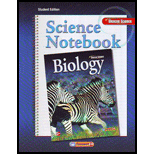
Concept explainers
To define:
The given terms using a book or a dictionary
Introduction: Invertebrate chordates have features linking them to vertebrate chordates. Chordates are animals belonging to the phylum Chordata. Vertebrates are animals with backbones. Most chordates are vertebrates.
Answer to Problem 3MI
Chordate − An animal belonging to phylum Chordata. It has four main features- a dorsal tubular nerve cord, a notochord, pharyngeal pouches, and a postanal tail- at some stage during development.
Invertebrate chordate − It is an animal belonging to phylum Chordata that has a dorsal tubular nerve cord, a notochord, pharyngeal pouches, a postanal tail and possibly an ancestral thyroid gland but no backbone.
Notochord − It is a flexible, rodlike structure that extends the length of the body and is located just below the dorsal tubular nerve cord.
Postanal tail − It is a structure used mainly for locomotion and is located behind the
Dorsal tubular nerve chord - It is a tube shaped nerve cord located dorsal to the digestive organs.
Pharyngeal pouch − It is a structure that occurs in pairs in all chordate embryos; connects the muscular tube that links the mouth cavity and the esophagus.
Explanation of Solution
Chordates have four main features- a dorsal tubular nerve cord, a notochord, pharyngeal pouches, and a postanal tail- at some stage during their development. All chordates might also have some form of thyroid gland. In addition to this they also have a coelom and segmentation. Invertebrate chordates which belong to either of the two subphyla of chordates- Cephalochordata and Urochordata, also have a dorsal a dorsal tubular nerve cord, a notochord, pharyngeal pouches, a postanal tail and possibly an ancestral thyroid gland but no backbone.
A Notochord is a flexible, rodlike structure that extends the length of the body and is located just below the dorsal tubular nerve cord. In most vertebrates the notochord is replaced by bones or cartilage but in invertebrate chordates the notochord remains. The flexibility of notochord enables the body to bend, rather than shorten.
Postanal tail is a structure used mainly for locomotion and is located behind the digestive system and anus. A free swimming animal moves efficiently by using a postanal tail. In most chordates the tail extends beyond the anus. The tail can propel an animal with more powerful movements than the body structure of invertebrates without a postanal tail.
Dorsal tubular nerve chord is a tube shaped nerve cord located dorsal to the digestive organs. The anterior end of the cord forms the brain and the posterior end becomes the spinal cord.
Pharyngeal pouch is a structure that occurs in pairs in all chordate embryos; connects the muscular tube that links the mouth cavity and the esophagus. In aquatic chordates the pouches contain slits that lead to the outside. These were first used for filter feeding and later evolved into gills for gaseous exchange. In terrestrial chordates they become tonsils and thymus glands.
Additional Science Textbook Solutions
Genetic Analysis: An Integrated Approach (3rd Edition)
Human Anatomy & Physiology (11th Edition)
Study Guide for Campbell Biology
Campbell Essential Biology with Physiology (6th Edition)
Human Biology: Concepts and Current Issues
Concepts of Genetics (11th Edition)
 Human Anatomy & Physiology (11th Edition)BiologyISBN:9780134580999Author:Elaine N. Marieb, Katja N. HoehnPublisher:PEARSON
Human Anatomy & Physiology (11th Edition)BiologyISBN:9780134580999Author:Elaine N. Marieb, Katja N. HoehnPublisher:PEARSON Biology 2eBiologyISBN:9781947172517Author:Matthew Douglas, Jung Choi, Mary Ann ClarkPublisher:OpenStax
Biology 2eBiologyISBN:9781947172517Author:Matthew Douglas, Jung Choi, Mary Ann ClarkPublisher:OpenStax Anatomy & PhysiologyBiologyISBN:9781259398629Author:McKinley, Michael P., O'loughlin, Valerie Dean, Bidle, Theresa StouterPublisher:Mcgraw Hill Education,
Anatomy & PhysiologyBiologyISBN:9781259398629Author:McKinley, Michael P., O'loughlin, Valerie Dean, Bidle, Theresa StouterPublisher:Mcgraw Hill Education, Molecular Biology of the Cell (Sixth Edition)BiologyISBN:9780815344322Author:Bruce Alberts, Alexander D. Johnson, Julian Lewis, David Morgan, Martin Raff, Keith Roberts, Peter WalterPublisher:W. W. Norton & Company
Molecular Biology of the Cell (Sixth Edition)BiologyISBN:9780815344322Author:Bruce Alberts, Alexander D. Johnson, Julian Lewis, David Morgan, Martin Raff, Keith Roberts, Peter WalterPublisher:W. W. Norton & Company Laboratory Manual For Human Anatomy & PhysiologyBiologyISBN:9781260159363Author:Martin, Terry R., Prentice-craver, CynthiaPublisher:McGraw-Hill Publishing Co.
Laboratory Manual For Human Anatomy & PhysiologyBiologyISBN:9781260159363Author:Martin, Terry R., Prentice-craver, CynthiaPublisher:McGraw-Hill Publishing Co. Inquiry Into Life (16th Edition)BiologyISBN:9781260231700Author:Sylvia S. Mader, Michael WindelspechtPublisher:McGraw Hill Education
Inquiry Into Life (16th Edition)BiologyISBN:9781260231700Author:Sylvia S. Mader, Michael WindelspechtPublisher:McGraw Hill Education





